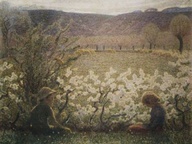Ninfa di Fontainebleau
Benvenuto Cellini, le célèbre orfèvre italien à la vie aventureuse, réalisa cette fonte monumentale à la demande de François Ier, prestigieux mécène de la Renaissance. Il sculpte un véritable hymne à la beauté féminine avec ce corps nu, long et souple, mis en valeur par l'évocation naturaliste et lyrique de l'univers sylvestre.
Benvenuto Cellini effectue un second séjour en France de 1540 à 1545, à la Cour de François Ier. Le roi lui commande le décor de la Porte dorée, entrée principale du château de Fontainebleau. L'artiste conçut l'immense relief de bronze, semi-circulaire, représentant La Nymphe de Fontainebleau, pour servir de tympan. Les relations du roi et du sculpteur se détériorèrent et Cellini quitta la France en 1545. Le roi mourut en 1547 et l'oeuvre ne fut jamais mise en place. Finalement, Philibert Delorme l'installa au-dessus du portail du château d'Anet, construit pour la maîtresse du roi Henri II, Diane de Poitiers. L'oeuvre marque l'orientation résolue de Cellini vers la sculpture. À son retour à Florence, il réalisera la fonte monumentale du Persée (Florence, Loggia dei Lanzi).
La Nymphe est le premier grand bronze de l'artiste. Il utilise le procédé de la fonte à la cire perdue, en plusieurs morceaux remontés ensuite. Il raconte avec force détails les péripéties de cette fonte qui faillit échouer. Il confie la réparure et le ciselage à des sculpteurs français, dont Pierre Bontemps. Mais on reconnaît les traits propres de Cellini : bouche soulignée d'un trait net avec la lèvre inférieure infléchie au milieu, pupilles dilatées, dessin des paupières, arcade sourcilière à petites stries figurant la pilosité.
Le relief reprend l'iconographie d'une fresque du Rosso (détruite mais connue par la gravure), au centre de la galerie François Ier. Elle représente la légende qui donna son nom à Fontainebleau : au cours d'une chasse, un chien de la meute royale, nommé Bliaud, découvrit une source, ce fut la fontaine de Bliaud. Comme dans l'art gréco-romain, la source est personnifiée par une nymphe accoudée sur une urne. Cellini enrichit la composition de nombreux animaux évoquant la forêt. La nymphe enlace le cou d'un cerf, un des emblèmes de François Ier, manifestant ainsi le plaisir du lieu à accueillir le monarque.
À Anet, grâce au caractère cynégétique de la composition, la nymphe devint aisément Diane, déesse de la chasse, modèle poétique de la maîtresse du lieu. À la Révolution, le cerf fut mutilé comme symbole du droit féodal de la chasse.
Cellini sculpte un corps svelte, ferme et souple, conforme au canon maniériste. Son extrême élongation s'adapte à l'espace de la lunette, dans un souci décoratif. Le visage a la beauté austère de la sculpture antique. Ce nu stylisé est toutefois plein de sensualité. Le modelé lisse des chairs est souligné par les plis serrés et parallèles de la draperie et les volutes de l'eau. Il contraste avec les fourrures des bêtes.
À l'opposé de l'idéalisation féminine, le sculpteur évoque les animaux avec une sensibilité naturaliste : soies hirsutes des sangliers, robe rase des chevreuils, caractère individualisé des chiens.
COMMENTI







